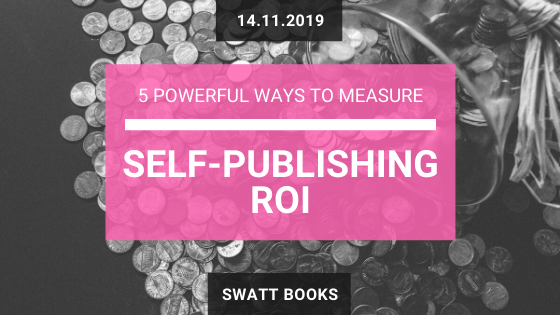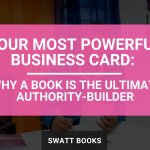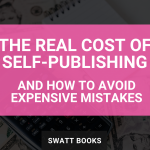Self-publishing ROI (Return on Investment) can be a touchy subject in the world of self-publishing. Since I became involved in self-publishing in 2015, I’ve spoken with numerous authors about their motivations for wanting to publish their book. I have heard a myriad of reasons as wide-ranging and varied as the subjects those authors have written about. But no matter your motivations for writing; self-publishing is a considerable investment and at some point, you will want to see some sort of return on that investment.
Many authors become blinkered to the idea that the only way to measure the ROI of your self-publishing investment is through copy sales. And yes, that is certainly the easiest way; but it is by no means the only way.
Here are my 5 top ways to measure self-publishing ROI, so that you can truly judge whether you and your book have achieved what you set out to do by publishing it.
1. Book Sales
Book sales are the gold standard of measuring self-publishing ROI, as it’s the simplest equation. Money spent minus money earned equals ROI. As soon as the resulting figure equals zero, you’ve recuperated your investment.
The best way to track this is to calculate your break-even point in terms of the number of copies you need to sell to recuperate your initial publishing investment. During the book listing process; whether you are using Amazon KDP or IngramSpark, you will be told how much profit (royalty) you will earn from each copy sold through a retail channel. Take the total financial investment you have spent to publish your book (excluding any PoD printing costs) and divide it by the royalty amount. THAT is the number of books you need to sell to recuperate your investment.
If you are not publishing via a Print on Demand (PoD) service and are selling your books via a self-fulfilment model using a Fulfilled by Amazon (FBA) account, then you do need to add the cost of getting each batch of books produced by your printer to your total investment figure. Be sure to include any delivery charges both to you and to your local Amazon distribution centre.
2. New Clients
If you are publishing a book to support your business, then the next best way to measure self-publishing ROI is by calculating it against the financial return of winning a new client as a result of publishing the book.
Publishing a book on the same subject on which you base your business and then working it into your sales process is a great way to boost your sales almost overnight. The marketing that you put into your book has the dual effect of also marketing both you and your business. In turn, your book will help attract new prospects to you whom you may not have reached with your previous marketing efforts. Also, the quality of those new prospects will be of a much higher calibre as they will come to you already pre-sold both on your business and you as a person with whom they want to work with. This all makes the sales process that much easier.
So how do you calculate your ROI based on new client acquisition? Very similarly to book sales. Take the average cost of your product/service that you charge to a client and plug that into the book sales break-even equation that we discussed above in place of royalty. So, the equation now reads as total financial investment divided by average product/service cost equals the number of new clients you need to acquire to break even. Unless you are selling a low-ticket price product or service, you will find that this dramatically reduces the number of transactions needed for you to break even!
3. ‘Expert’ Status
Now we start to get into the less tangible aspects of ROI, in terms of looking at the effect that publishing your book has on you and your surrounding business.
If you’ve read some of my previous blog posts, you’ll know that publishing a book on the same subject on which you base your business helps establish you as the go-to expert on that subject. A natural bi-product of being regarded as an expert in a particular field is that people are generally willing to pay more to work with ‘the best’.
Though this in itself isn’t a measurable return on investment, it does have a considerable effect on the New Clients ROI calculation. If the average cost of your product/service increased by 10%, the resulting number of transactions needed for you to break even reduces by the same amount. Think about what’s better… to sell 100 widgets at £10 or 10 widgets at £100?
By the way… this can apply to fiction authors too. Would you consider Stephen King, J.K Rowling or Andy Weir expert writers in their respective genres? Of course, you would. Though this may not mean you can increase the cover price of your books by the same percentages as I mention in client services being offered by non-fiction writers, it definitely can have an impact on the number of books you sell.
4. Speaking Gigs
Another byproduct of being regarded as an expert is that people want to know what you know. They want to hear what you have to say and see if they can learn some of your secrets to success. Welcome to the world of public speaking!
This is not for everyone. I know many authors who are amazingly eloquent with a pen but put them on a stage in a room full of real live people and they get tongue-tied over the simplest sentence. If you can master your nerves, start doing speaking engagements at libraries, conferences, and literary festivals. The more you get known on the speaking circuit, the more speaking gigs you get booked for, and soon enough people will start paying you to speak on their stages! This does take time, practice and patience. But when it all starts to come together, it’s yet another source of revenue that you can add to your income pot that helps get you closer to that magical break-even point.
5. Social Philanthropy
Though we live in a very cash-driven society, not all ROI needs to be calculated in pounds and pence; dollars and cents. I know many authors whose only driver for publishing a book is to give back to the community in some form or another. For them, the reward of being able to genuinely help someone is worth the investment of publishing a book.
There is no financial calculation for this type of ROI; it’s what you feel is a suitable exchange of investment versus reward. As long as you can pay your bills, put food on the table, a roof over your head, then giving back to the community through publishing is a noble and honourable pursuit.
As an aside, if this is something that you would like to do, but aren’t too sure how to set up, talk to the guys at Work For Good (https://workforgood.co.uk). They make it easy for small business owners and authors to donate to charity through sales by helping to manage all of the logistics and legal compliance.
So as you can see, just as there is more than one way to skin a cat, there are more ways to measure self-publishing ROI than just tracking book sales. By keeping an eye on that all-important break-even number, you will not only feel less stressed about investing in publishing your book, but you will ultimately achieve greater success as a result.
There is a quote that constantly gets circulated in business circles that has been attributed to numerous people in different guises that basically says “What gets measured gets managed”. This is so very true. If you know the target that you are aiming for (your break-even figure), and you measure regularly where you are concerning that target, then it is always front of mind what you need to do to reach that target.
So work out what your break-even figure is, then each month when you receive your sales reports from Ingram or KDP, take a look at how much closer you are. You will be surprised at the impact it can have on your motivation to continue marketing your book… which is a topic for another day J






Trackbacks/Pingbacks